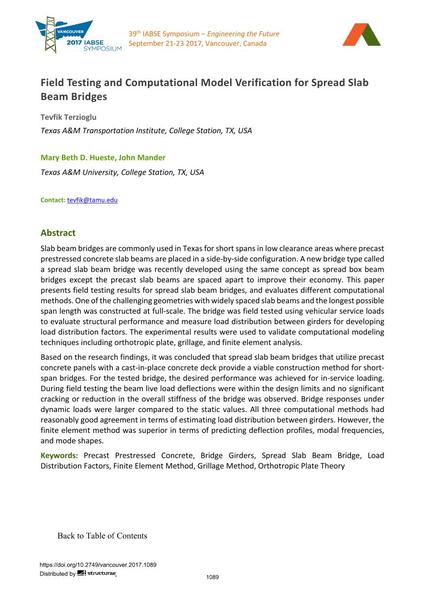Field Testing and Computational Model Verification for Spread Slab Beam Bridges

|
|
|||||||||||
Bibliographic Details
| Author(s): |
Tevfik Terzioglu
(Texas A&M Transportation Institute, College Station, TX, USA)
Mary Beth Hueste (Texas A&M University, College Station, TX, USA) John Mander (Texas A&M University, College Station, TX, USA) |
||||
|---|---|---|---|---|---|
| Medium: | conference paper | ||||
| Language(s): | English | ||||
| Conference: | IABSE Symposium: Engineering the Future, Vancouver, Canada, 21-23 September 2017 | ||||
| Published in: | IABSE Symposium Vancouver 2017 | ||||
|
|||||
| Page(s): | 1089-1097 | ||||
| Total no. of pages: | 9 | ||||
| Year: | 2017 | ||||
| DOI: | 10.2749/vancouver.2017.1089 | ||||
| Abstract: |
Slab beam bridges are commonly used in Texas for short spans in low clearance areas where precast prestressed concrete slab beams are placed in a side-by-side configuration. A new bridge type called a spread slab beam bridge was recently developed using the same concept as spread box beam bridges except the precast slab beams are spaced apart to improve their economy. This paper presents field testing results for spread slab beam bridges, and evaluates different computational methods. One of the challenging geometries with widely spaced slab beams and the longest possible span length was constructed at full-scale. The bridge was field tested using vehicular service loads to evaluate structural performance and measure load distribution between girders for developing load distribution factors. The experimental results were used to validate computational modeling techniques including orthotropic plate, grillage, and finite element analysis. Based on the research findings, it was concluded that spread slab beam bridges that utilize precast concrete panels with a cast-in-place concrete deck provide a viable construction method for short- span bridges. For the tested bridge, the desired performance was achieved for in-service loading. During field testing the beam live load deflections were within the design limits and no significant cracking or reduction in the overall stiffness of the bridge was observed. Bridge responses under dynamic loads were larger compared to the static values. All three computational methods had reasonably good agreement in terms of estimating load distribution between girders. However, the finite element method was superior in terms of predicting deflection profiles, modal frequencies, and mode shapes. |
||||
| Keywords: |
finite element method (FEM) spread slab beam bridge Bridge Girders Load Distribution Factors Grillage Method Orthotropic Plate Theory
|
||||
